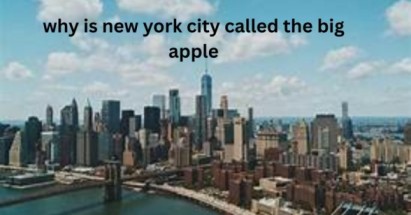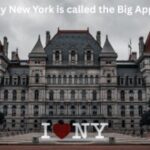Introduction
Why Is New York City Called the Big Apple: When people think about New York City, many nicknames come to mind: “The City That Never Sleeps,” “Gotham,” and the most famous one of all—“The Big Apple.” But have you ever wondered, why is New York City called the Big Apple? The phrase sounds playful and almost mysterious, yet it carries with it a long history that touches horse racing, jazz culture, tourism campaigns, and even myths that are still debated today.

In this article, we’ll explore seven incredible stories that explain Why Is New York City Called the Big Apple, tracing its journey from slang to an official identity. Along the way, we’ll also uncover how the nickname became central to the city’s image, why it resonates so deeply with locals and visitors alike, and how it has stood the test of time.
1. The Horse Racing Origins of the Big Apple
The most widely accepted story behind why is New York City called the Big Apple starts in the 1920s with the world of horse racing. At that time, New York City was home to some of the country’s most prestigious racetracks. Winning in New York wasn’t just a victory—it was the ultimate prize, the “big apple” that every jockey and horse owner dreamed of.
John J. Fitz Gerald, a sportswriter for the New York Morning Telegraph, is credited with popularizing the phrase. Beginning in 1921, he used “Around the Big Apple” as the title of his racing column. Fitz Gerald claimed he picked up the term from African American stable hands in New Orleans who referred to New York racetracks as “the Big Apple,” meaning the biggest rewards in horse racing.
This horse racing connection highlights the idea that New York was the ultimate place for success. Just like a juicy, desirable apple, the city represented the grandest prize of them all.
2. The Jazz Age Adoption
Another key chapter in the story of why is New York City called the Big Apple lies in the cultural explosion of the Jazz Age. During the 1930s, jazz musicians embraced the term “Big Apple” to describe New York City. Harlem, in particular, became a hotspot for jazz and swing, and musicians would say, “There are many apples on the tree, but only one Big Apple.”
For jazz artists, the Big Apple symbolized making it big in the music world. Playing in New York meant you had arrived, performing on the grandest stage of them all. The nickname spread quickly across the entertainment world, solidifying New York as the dream destination for performers.
This adoption by jazz musicians also connected the term with African American culture, highlighting the importance of Harlem and its thriving music scene in shaping the city’s identity.
You can see this also;
- “Big Apple New York: 5 Incredible Secrets Behind It”
- 10 Irresistible Reasons Your Next Air Transat Vacation Will Change Your Life Forever
- Best Travel Insurance for Seniors in the USA: 2025 Guide to Safe, Stress-Free Adventures
3. Myths and Misconceptions
While horse racing and jazz culture provide the strongest evidence, several myths also surround why is New York City called the Big Apple. These stories, though less credible, add color to the nickname’s mystique.
One myth suggests that the name came from a madam named “Eve” who ran a brothel in the city, with her workers referred to as “apples.” Another story ties the name to apple vendors during the Great Depression, when struggling workers sold apples on the streets for five cents each.
Although these myths lack historical evidence, they show how ordinary people tried to make sense of the unusual nickname. The fact that so many legends exist around the term only deepens its cultural appeal.
4. The Decline and Revival of the Big Apple
By the mid-20th century, the nickname had fallen out of common use. Other terms like “Gotham” and “The City That Never Sleeps” dominated popular culture. But the question of why is New York City called the Big Apple resurfaced in the 1970s during a very different chapter in the city’s history.
At that time, New York was facing an economic crisis, rising crime, and a declining image worldwide. To improve its reputation, the New York Convention and Visitors Bureau launched a promotional campaign reviving the phrase “The Big Apple.” Slogans like “Take a Bite Out of the Big Apple” appeared on billboards, T-shirts, and buttons.
This campaign successfully rebranded New York as an exciting and welcoming tourist destination. The nickname gained new life and has remained closely tied to the city ever since.
5. Symbol of Ambition and Success
One of the reasons why is New York City called the Big Apple is that the nickname perfectly reflects the city’s global reputation as a place of ambition and opportunity. Just like a big apple represents the juiciest, most desirable fruit, New York City symbolizes the ultimate goal for dreamers, workers, artists, and entrepreneurs.
Whether it’s Wall Street, Broadway, or Madison Avenue, New York offers the world’s largest stages for finance, theater, media, and innovation. The phrase continues to resonate because it captures the spirit of striving for something bigger—the dream of making it in New York.
This metaphor has helped cement the nickname’s staying power, ensuring that generations still see the Big Apple as a symbol of success.
6. The Role of Marketing and Media
Another part of why is New York City called the Big Apple has to do with how effectively the term was marketed. From newspapers to music clubs, from tourism campaigns to Hollywood movies, the phrase has appeared everywhere.
The 1970s campaign was especially influential. By turning the Big Apple into a logo and slogan, the city gave tourists and locals a sense of ownership over the name. Today, you’ll find it on souvenirs, travel guides, and even the red apple sculpture near the Lincoln Center.
In marketing terms, the Big Apple nickname works because it’s simple, visual, and memorable. It gives people an image they can instantly associate with New York City.
7. Why the Nickname Still Matters Today
Finally, the most important reason why is New York City called the Big Apple remains relevant is because the nickname still embodies the city’s identity in the 21st century. Despite challenges—from economic downturns to global pandemics—New York continues to be seen as a city of resilience, diversity, and opportunity.
The Big Apple stands not just for a place, but for an idea of greatness. It reminds people that New York is where cultures meet, where ambition thrives, and where anything is possible. The fact that this nickname has survived for a century is proof of its deep emotional and cultural connection.
Frequently Asked Questions (FAQs)
1. What is the real reason Why Is New York City Called the Big Apple?
The most reliable origin comes from horse racing in the 1920s. Sportswriter John J. Fitz Gerald popularized the phrase after hearing stable hands refer to New York racetracks as “the Big Apple,” meaning the ultimate prize.
2. Did jazz musicians play a role in the nickname?
Yes. In the 1930s, jazz musicians in Harlem adopted “Big Apple” to describe New York as the most prestigious place to perform, spreading the phrase into popular culture.
3. Are there myths about the nickname?
Several myths exist, such as apple vendors during the Great Depression or a brothel madam named Eve, but these lack historical evidence.
4. When did New York officially start using the nickname?
In the 1970s, the New York Convention and Visitors Bureau launched a campaign to promote tourism, reviving and officially branding the city as “The Big Apple.”
5. Why is the nickname still popular today?
The phrase represents ambition, success, and opportunity. It continues to symbolize New York City as a place where dreams can come true.
Conclusion
So, why is New York City called the Big Apple? The answer is a fascinating mix of history, culture, and symbolism. From its humble beginnings in the horse racing world to its adoption by jazz musicians, from myths that captured imaginations to a powerful tourism revival in the 1970s, the nickname has evolved into a lasting symbol of ambition and opportunity.
Today, when people say “The Big Apple,” they’re not just talking about a city—they’re talking about a dream, an idea, and a way of life that represents the best of New York. And that’s why the nickname still matters just as much today as it did a century ago. Wikipedia








